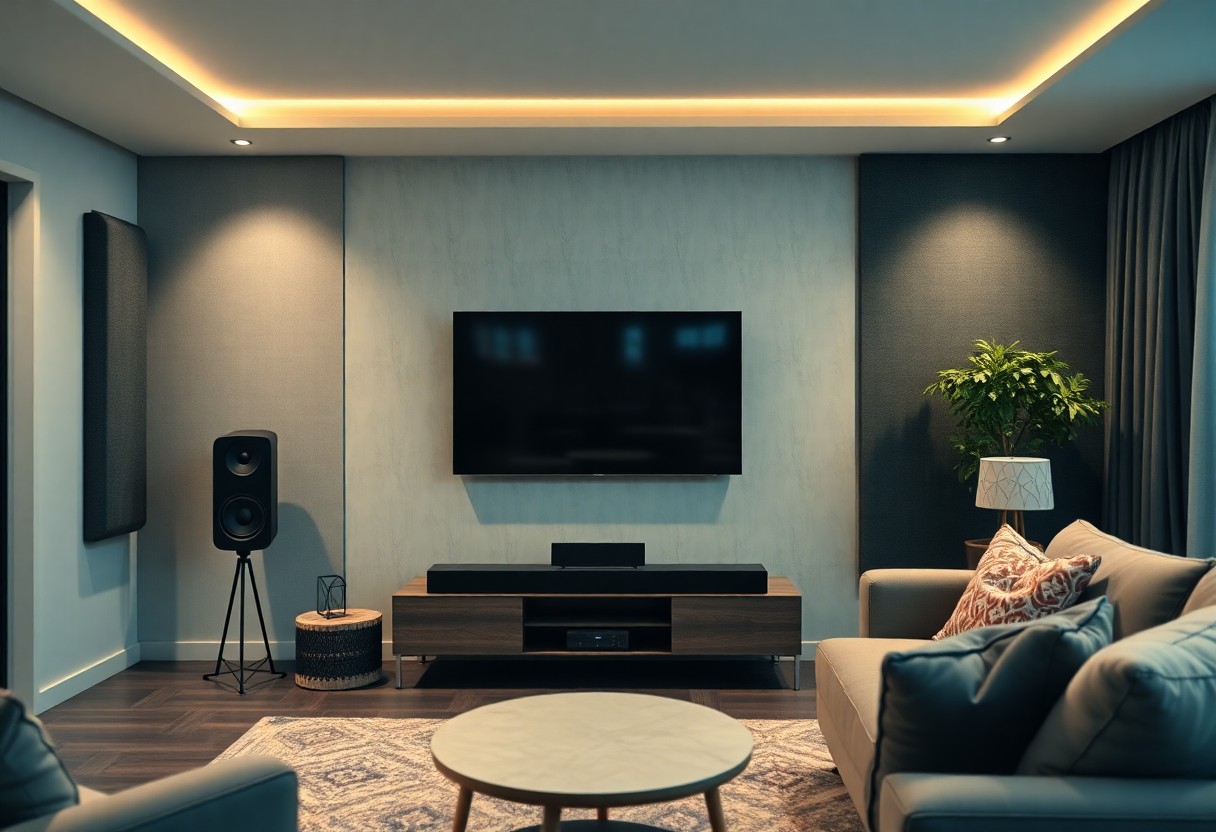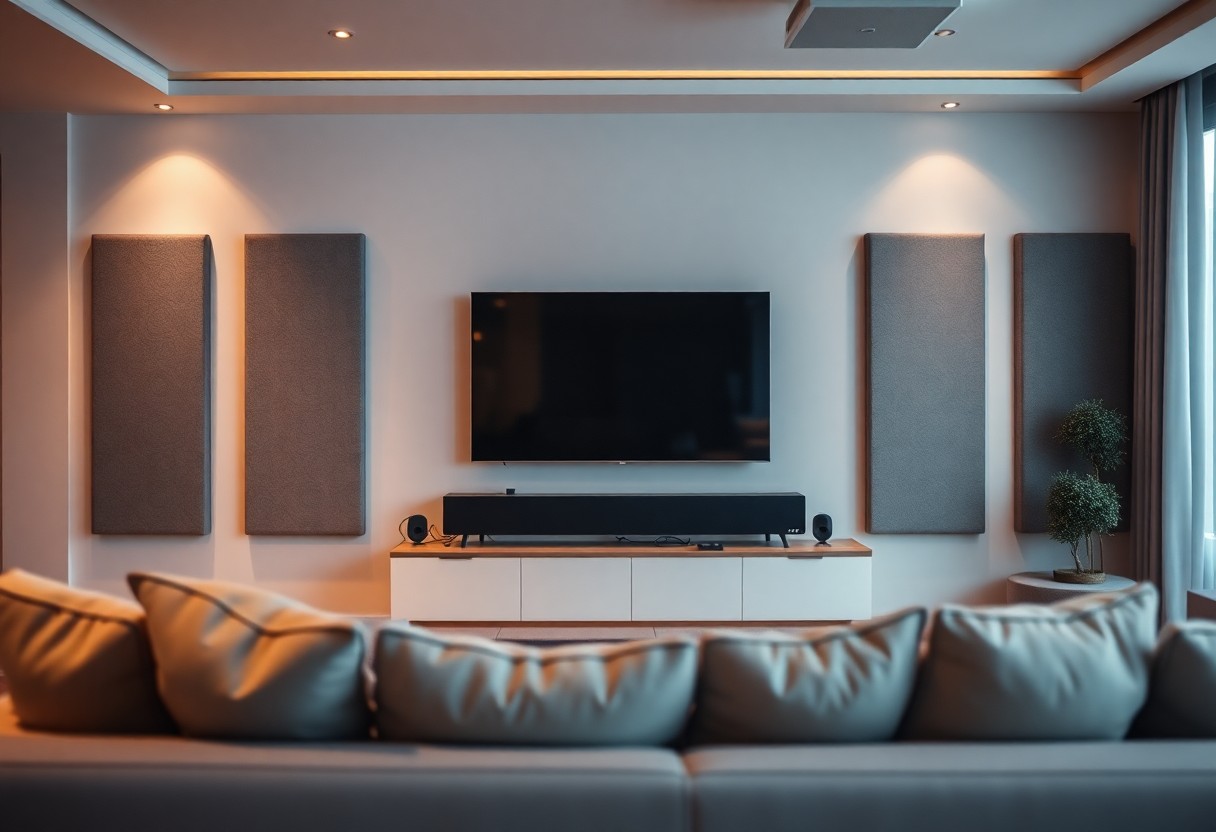You can transform your listening experience by optimizing your room’s acoustics with a stylish soundbar. In this guide, you’ll discover practical tips and techniques that will elevate the audio quality in your space, making it more immersive and enjoyable. From positioning your soundbar to adjusting settings for optimal performance, these imperative steps will enhance both the aesthetics and functionality of your room. Let’s examine how you can achieve a perfectly tuned environment tailored to your audio needs.
Contents
- Understanding Acoustics
- What are Room Acoustics?
- Importance of Acoustic Optimization
- Selecting the Right Soundbar
- Types of Soundbars
- Features to Consider
- Key Factors Affecting Acoustics
- Room Size and Shape
- Surface Materials and Furnishings
- How to Position Your Soundbar
- Ideal Placement Strategies
- Avoiding Common Placement Mistakes
- Tips for Enhancing Sound Quality
- Additional Acoustic Treatments
- Adjusting Soundbar Settings
- Troubleshooting Acoustic Issues
- Identifying Common Problems
- Solutions to Improve Sound
- Final Words
Understanding Acoustics
For anyone looking to enhance their audio experience, understanding room acoustics is vital. This involves how sound behaves in your living space, which includes its absorption, reflection, and diffusion properties. Properly assessing and treating your environment can lead to a remarkable difference in sound quality, ensuring you enjoy every note and dialogue with clarity.
What are Room Acoustics?
For your space, room acoustics refers to the interplay of sound waves in a particular environment. These waves interact with surfaces such as walls, floors, and ceilings, influencing how sound is perceived. Various factors, including room shape, size, and the materials used in decor, play a significant role in determining the overall acoustic quality of your space.
Importance of Acoustic Optimization
An optimized acoustic environment allows you to maximize sound clarity and impact. When your room is acoustically tuned, you reduce unwanted noise and echo while enhancing the natural sounds from your soundbar or speakers. This not only improves your listening experience but also creates a more immersive atmosphere for movies and music.
Another key point to appreciate is how acoustic optimization can significantly benefit your overall well-being. A well-tuned room fosters better communication, reduces stress from excessive noise, and enhances focus. By investing time in understanding and implementing acoustic treatments, you create a versatile space where every audio experience is pleasant and enriching.

Selecting the Right Soundbar
One of the crucial steps in enhancing your room’s acoustics is selecting the right soundbar. With a variety of options available, it’s important to choose one that complements your space and audio needs. Factors like size, audio quality, and connectivity should guide your selection process to ensure that you get optimal sound performance tailored to your home environment.
Types of Soundbars
One way to understand soundbars is by exploring the different types available in the market. Each type caters to varied preferences and setups:
- Standard Soundbars
- Soundbar with Subwoofer
- Surround Sound Soundbars
- Smart Soundbars
- Portable Soundbars
Recognizing the type that fits your lifestyle is key to achieving the best sound experience in your room.
| Type | Description |
| Standard Soundbars | Basic models offering improved TV audio. |
| Soundbar with Subwoofer | Includes an additional subwoofer for deeper bass. |
| Surround Sound Soundbars | Designed to simulate a multi-speaker setup. |
| Smart Soundbars | Integrated voice assistant and streaming services. |
| Portable Soundbars | Compact and easy to move for versatility. |
Features to Consider
The right soundbar comes with features that enhance your listening experience and fit your room’s acoustics. When identifying a soundbar, consider the audio output, connectivity options, and any additional technologies that might improve sound quality.
Features to evaluate include surround sound capabilities, Bluetooth or Wi-Fi connectivity for streaming, and control options like remote or app functionalities. Additionally, look for compatibility with your existing devices and whether it supports high-definition audio formats. These elements play a significant role in crafting an immersive experience in your space, aligning with your acoustic objectives.
Key Factors Affecting Acoustics
Some key factors can significantly influence the acoustics in your room. Understanding these elements can help you create a more enjoyable listening experience. Consider the following:
- Room size
- Room shape
- Surface materials
- Furnishings
The integration of these factors plays a vital role in optimizing your soundbar’s performance.
Room Size and Shape
Affecting acoustics, the dimensions and configuration of your room impact sound distribution and clarity. A larger space can create echoes and reverberation, while smaller rooms may cause sound to be trapped, leading to muddiness. The shape of your room, whether it’s square or rectangular, also influences how sound waves bounce around, making it imperative to assess these elements for optimal audio performance.
Surface Materials and Furnishings
Materials in your room serve as modifiers of sound properties. The type of surfaces—be it walls, floors, or ceilings—can absorb or reflect sound waves, affecting clarity and overall sound quality. Similarly, the furnishings you choose, such as curtains, rugs, and upholstered furniture, enhance or dampen acoustics.
Acoustics play a significant role in your listening experience, as every surface interacts with sound in unique ways. Hard surfaces like tile or glass can create echoes and enhance mid and high frequencies, while soft furnishings absorb sound, reducing unwanted reflections. When opting for materials and arranging your furnishings, think about balancing sound absorption and reflection to maintain a harmonious acoustic environment in your space.

How to Position Your Soundbar
Many factors contribute to maximizing your soundbar’s audio performance, starting with its positioning. By placing your soundbar in the optimal location, you can enhance your listening experience and ensure that sound waves travel freely throughout the room. Proper soundbar placement allows for a clear and immersive audio experience, setting the mood for movies, music, or gaming.
Ideal Placement Strategies
Soundbar placement is crucial for achieving the best acoustics. Ideally, you should position your soundbar directly below your television, at ear level when seated. This alignment helps in creating a more cohesive listening experience. Additionally, leaving some space between the soundbar and the wall can improve sound projection and reduce distortion, enhancing overall sound quality.
Avoiding Common Placement Mistakes
Your soundbar’s effectiveness can be undermined by poor placement choices. Keeping it too close to walls or other surfaces might lead to muffled audio, while placing it above your line of sight can complicate sound directionality. Make sure to avoid obstructions, as they can hinder sound quality and placement of speakers can directly affect your audio experience.
Mistakes in soundbar placement often arise from impulse decisions or a lack of awareness. Many people underestimate how furniture and room shape can affect sound propagation. It’s crucial to ensure that your soundbar has a clear line of sight to your seating area and is not blocked by items like TV stands, plants, or decorative pieces. Additionally, avoid placing the soundbar in corners or enclosed spaces, as this can lead to unwanted bass buildup and muddied sound. Prioritizing an open and strategic placement can dramatically enhance your audio experience.
Tips for Enhancing Sound Quality
Unlike standard speakers, soundbars require strategic adjustments to maximize their performance. Here are a few tips you should implement to elevate your audio experience:
- Position the soundbar at ear level for optimal listening.
- Place the soundbar away from walls to minimize reflections.
- Consider using a subwoofer for deeper bass sounds.
- Experiment with different sound modes tailored to your content.
Thou will appreciate the enhanced audio quality. For more insights on this topic, check out Small Space, Big Sound: How Soundbars Improve Your Audio ….
Additional Acoustic Treatments
An effective way to improve your room’s acoustics is by incorporating additional acoustic treatments. Use soft furnishings such as rugs, curtains, and upholstered furniture to help absorb sound waves, reducing echo and reverberation. Consider adding wall panels or bass traps to further enhance sound clarity and balance, creating a more enjoyable listening environment.
Adjusting Soundbar Settings
Now that you have positioned your soundbar appropriately, fine-tuning its settings can make a significant difference. Access your soundbar’s menu to adjust equalizer settings, sound modes, and any surround sound features. Each setting can vastly alter the audio experience, so take the time to customize these options based on your listening preferences and room layout.
Treatments such as these allow you to tailor your soundbar’s performance to match your environment. By adjusting settings like treble and bass levels, you can counterbalance any acoustic anomalies in your room. Make sure to test various configurations while playing different types of media to find the perfect sound profile that aligns with your personal taste.
Troubleshooting Acoustic Issues
All rooms have unique acoustics, and issues can arise that detract from your sound experience. It’s necessary to identify any problems and make adjustments to ensure your soundbar delivers the best performance possible. By taking some time to troubleshoot, you’ll create a more enjoyable listening environment that complements your space.
Identifying Common Problems
There’s a variety of acoustic issues that can affect your sound quality. These may include echoes, sound reflections from hard surfaces, or uneven sound distribution, which can lead to a subpar experience while enjoying your media. Identifying these specific issues will empower you to address them effectively.
Solutions to Improve Sound
To optimize your room’s acoustics, consider employing a combination of strategies that address the identified problems. Begin by adjusting the placement of your soundbar and speakers to achieve better sound dispersion. You might also incorporate sound absorptive materials, such as carpets and curtains, to minimize reflections and reduce echo.
Solutions may include rearranging furniture, using acoustic panels, or investing in quality rugs to dampen sound. You can also experiment with tuning settings on your soundbar. By assessing your room’s layout and utilizing available materials, you create a more harmonious sound environment tailored to your specific needs.
Final Words
Hence, optimizing your room’s acoustics with a sleek soundbar can significantly enhance your audio experience. By strategically positioning your soundbar, utilizing acoustic treatments, and fine-tuning settings, you create an immersive environment that complements your space. Pay attention to elements such as furniture placement and wall materials to further improve sound quality. With these strategies, you can elevate your audio enjoyment and transform any room into a personal concert hall.

Leave a Reply